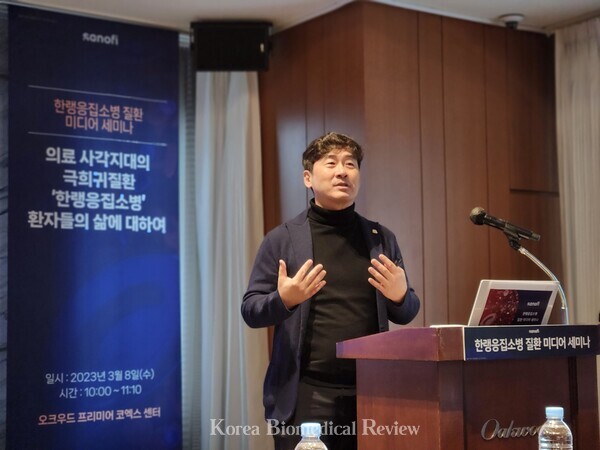“Although the disease only affects a handful in Korea, cold agglutinin disease (CAD) patients suffer year-round and there is no safe and effective treatment yet approved in Korea so we first need to raise awareness to help these patients,” said a Korean hematologist at a recent press conference.

Sanofi-Aventis Korea held a media seminar to raise awareness of the plight of CAD patients, an extremely rare disease in the medical blindspot, at the Oakwood Premier COEX Center, in Seoul on Wednesday.
Cold agglutinin disease (CAD) is an extremely rare autoimmune hemolytic anemia (AIHA) in which the immune system mistakenly attacks and destroys red blood cells repeatedly. It occurs when abnormal bone marrow cells produce antibodies, called cold agglutinins, and activate the complement pathway of the immune system.
Professor Jang Jun-ho of Haematology and Oncology at Samsung Medical Center presented the disease burden and the domestic context for diagnosing and treating CAD patients.
The disease burden is estimated to be approximately one out of every 1 million people which can increase to 5 to 20 per 1 million people depending on the climate. However, Korea does not have a disease code for CAD, so it is impossible to quantify patients, leaving them in a medical blindspot, Jang said.
Still, he estimated that there were around 100 patients suffering from CAD in Korea.
As the red blood cells are destroyed, organs and tissues receive less oxygen resulting in severe anemia, extreme fatigue, shortness of breath, weight loss, and hemoglobinuria.
He added that the mortality rate increases threefold over five years after diagnosis of cold coagulation disease, and the survival after diagnosis is only 8.5 years. In particular, the incidence of blood clots in patients with CAD was 30.4 per 1,000 people, which was twice as high as those without the disease.
Professor Jang also referenced the FACIT-Fatigue which measures the level of fatigue and its impact on daily activities and function, saying, “The score of patients with CAD was 32.5 points, which is similar to the fatigue score of patients with advanced cancer which falls between 28-39 points.”

Regardless of the season, patients are equally affected, Jang said.
“In winter, cold winds naturally affect them but in summer, patients are also very sensitive to fans and AC and even simple tasks like taking things out of the fridge or drinking cool water are difficult for them.”
Currently, Sanofi's Enjaymo (ingredient: sutimlimab) has been approved in the U.S., Europe, and Japan as a treatment to inhibit hemolysis of red blood cells in CAD patients, but approval has not yet been granted in Korea.
Explaining the local treatment environment, he said, “Patients generally avoid the cold and receive blood transfusions in emergency cases. We also use anticoagulants to reduce the number of patients who die from thromboembolism, but they are not sufficient to reduce the mortality rate.”
He went on to say that sometimes doctors resort to anticancer drugs to remove antibodies, but these are not officially approved for the treatment of CAD and the effect is not sustained.
When used in combination with chemotherapy, patients have to take the risk of toxicity and infection, he said.
“Diagnosis is not difficult, but as it is such a rare disease, patients often have to visit many hospitals before receiving the diagnosis as clinicians are sometimes also in the dark about this disease, adding to patients’ frustration,” explained Jang. "It is also important to draw awareness to this disease as insurance benefits will be another hurdle to overcome since few patients are involved."

